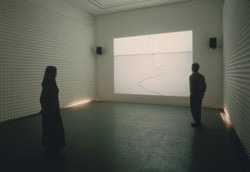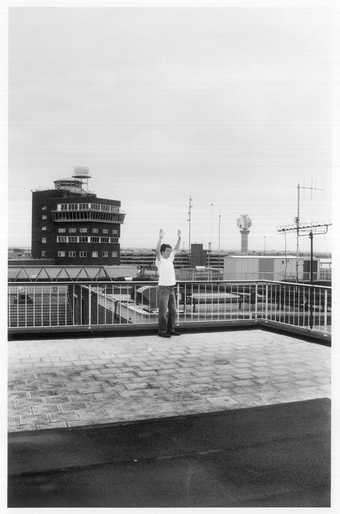We take ...our everyday external reality very much for granted: the room that we sit in, the streets around us, the virtual space of billboards, and movies and TV ... we take all this for granted. But in fact it is, literally speaking, an illusion generated by our central nervous system. It's as much a virtual reality as the one the cyber people are working on ...Within our minds all these different planes of spatial reality are intersecting.
J.G. Ballard, KGB 7, KGB Media, 1995
All of Graham Gussin's work engages in some way with the human experience of the infinite. He is conscious that our perception and understanding of the world is manipulated and transformed by a complex layering of mass communications and consumer culture. Often his work suggests a sense of displacement, playing on our desire to be somewhere else, in a different time or space.
He has been particularly influenced by science fiction, especially of the sort that presents a set of circumstances requiring resolution, such as H.G. Wells's The Island of Doctor Moreau, or touches on what J.G. Ballard has described as the 'internal landscape',
Any Object in the Universe relates to a romantic tradition of landscape, together with the idea of a uropian space which is often explored in these types of science fiction.
Much of Gussin's work is experiential, dependent on the viewer for its completion. In Beyond the Infinite of 1994, for example, the artist appropriated a scene from Stanley Kubrick's film 2001: A Space Odyssey. He edited and displayed two film loops of the same scene, one slightly longer than the other so that one loop appears to wait for, or follow, the other: 'The shorter loop has the spaceman wandering around the hotel, endlessly looking for himself. The longer loop includes not only this search but also the discovery of himself as an old man', Kubrick's narrative sequence is effectively disrupted. Standing between the two monitors, the viewer becomes a conductor of time and space between the two scenes.
States of mind seem to be the main subjects of Gussin's work, conditions or states that might be, for example, associated with the sublime, the sense of awe and wonder that takes one out of oneself, But it is the failure to find the sublime moment that he appears to linger on. In Fall (7200-1) he deals very literally with the agitated state of expectation, Confronted by a large video projection of an unspectacular landscape the viewer stands on the edge of it waiting for something to happen, Suddenly the tranquility and emptiness of the landscape is disturbed by something falling dramatically out of the sky, shattering the still surface of a lake: 'I like the idea that Fall embodies the possibility of this thing happening without anybody seeing it. The splash occurs infrequently so the subject of this piece isn't really the disturbance- rather it's the possibility of it happening'.
The idea for Any Object in the Universe stemmed from a short story by Edgar Allen Poe, A Tale Of The Ragged Mountains, which the artist summarises as follows: 'The whole text is a vision ...there is a character who takes a lot of opium and coffee. He then goes for a walk and slips into a previously unrecognised region within his geographic locality. Within that second or parallel space he dies, but somehow returns to tell the tale of his death in that space. When his tale is complete he dies in real space and time. So it's a kind of closed loop, returning in and out of and being effected by two parallel spaces, an illusory space that becomes so powerful that it results in death'.
A similar notion of slipping between two spaces underlies Any Object in the Universe. Walking in to a darkened room the viewer steps on to a slightly raised floor, each step producing an electronically generated echo. The walls are clad with what appears to be sound-proofing material. Projected on to one wall is an image of the same room, empty but for a microphone on a stand. Confusingly, the echo appears to be coming from the fictional, projected space. 'What at first seems to be an echo chamber becomes a space where sound cannot escape, a trap of some kind.' The viewer, like the echo, seems to be caught between a real and an imaginary space.
The other fictional space that influenced Gussin's making of Any Object in the Universe is the sound- proofed capsule depicted in Nicolas Roeg's 1976 film The Man Who Fell To Earth, a capsule where, as Gussin describes it, 'all sound is deadened and disappears ...It's an enclosed, very precise and exactly measured space, but also an infinite space ...In the film David Bowie falls to earth. The whole film is a struggle against gravity, ...about him attempting to get back into the sky, which he doesn't achieve'. Commenting on his use of an image from the cinema screen the artist has said, 'I like the way that filmic space spills out into reality'.
As if standing in front of a painting by Mark Rothko, or on the 'beam-me- up' platform in Star Trek, we stand on the raised floor, waiting for something to happen, desiring to be transported in some way to another dimension. The artist explains: 'What I was interested in trying to do was to place the viewer in the space that is projected, just for a split second, so that it makes him or her disappear from the space he or she is standing in to occupy that space, even just for the blink of an eye ...That's where the work really lies, in that momentary confusion of not being able to tell'.
Alongside Any Object in the Universe Gussin shows a number of black and white line drawings. Like the installation, these Drawings of Nothing and Nowhere explore how we experience space. The rectangular shapes seem to hover on the surface of the paper yet perspectivally they disappear towards a central vanishing point. As familiar as the introductory credits for Pearl and Dean advertising that prepare audiences for the immersive space of cinema, they ask the viewer to think about location, about their position in time and space. The drawings cannot succeed in the aim suggested by their title, instead they draw attention to the way we attempt to articulate and measure both internal and external space.
Text written by Virginia Button
Biography
Born 1960. Lives and works in London. 1981-85 Middlesex Polytechnic. 1989-90 Chelsea School of Art.
The 1997-8 exhibition programme is supported by the Patrons of New Art, Hereford Salon and Akeler Developments PLC.


